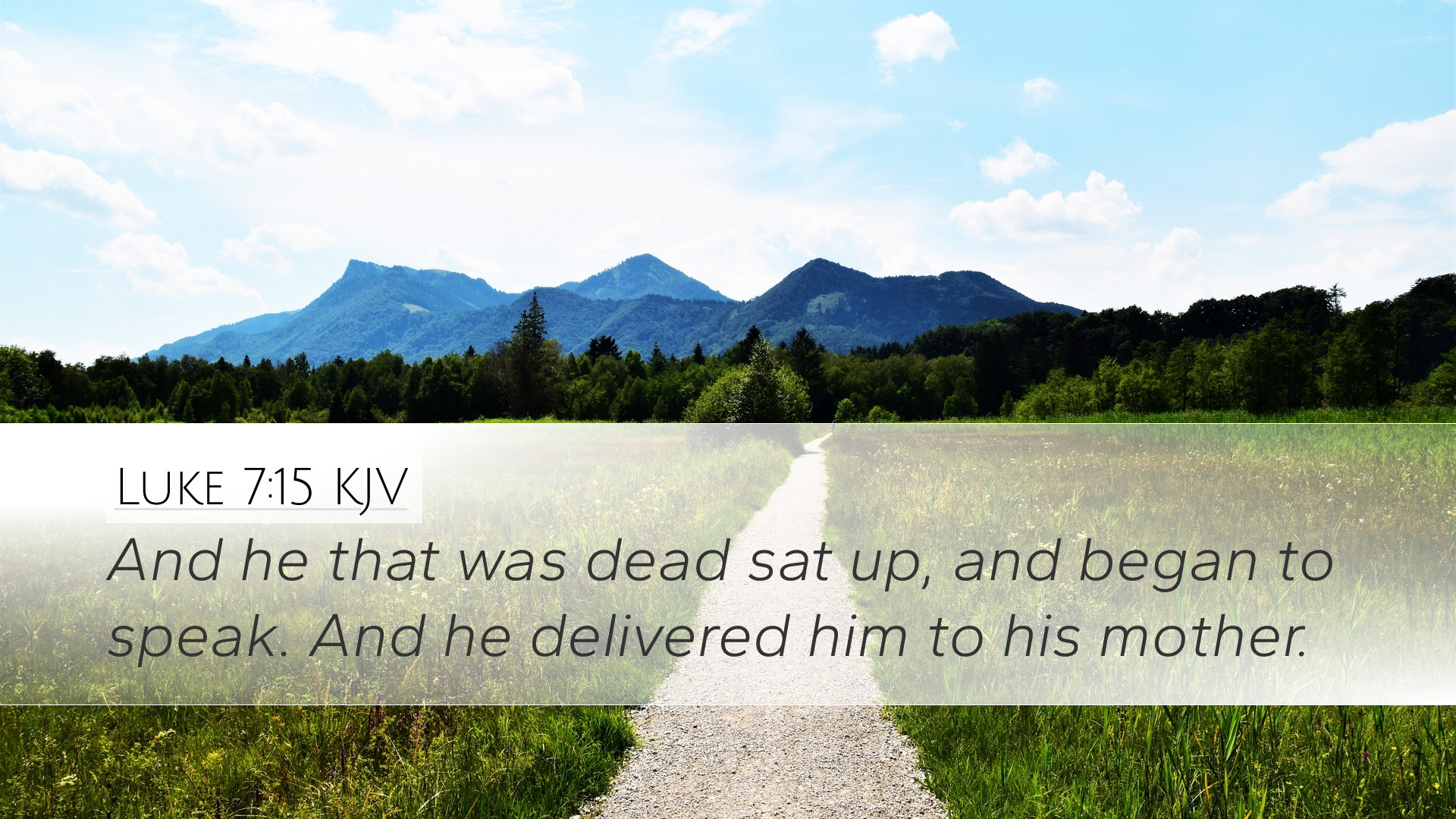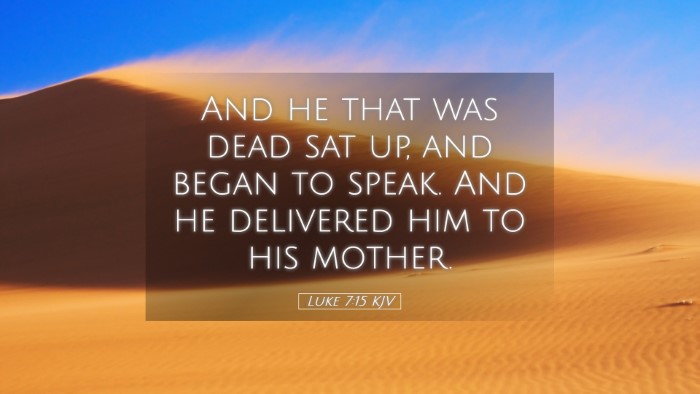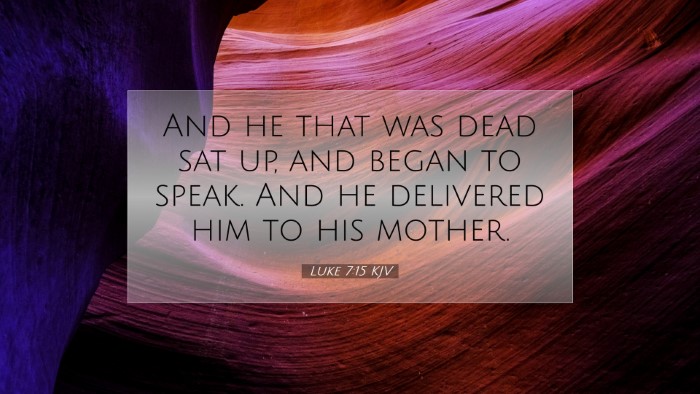Bible Commentary on Luke 7:15
Verse: "And he that was dead sat up, and began to speak. And he delivered him to his mother."
Introduction
This poignant moment in the Gospel of Luke captures the power of Christ over death and is a profound testament to His compassion. The raising of the widow’s son at Nain not only demonstrates Jesus’ miraculous abilities but also serves as a rich theological moment that can be examined through various lenses. In this commentary, we draw insights from noted public domain theologians including Matthew Henry, Albert Barnes, and Adam Clarke.
Contextual Overview
The event takes place in Nain, a town near Nazareth, illustrating both the locality of Jesus’ ministry and the intimate societal parallels of grief that resonate throughout the Scriptures. The narrative follows shortly after the Sermon on the Plain, where Jesus has established Himself as a teacher with authority. This miracle serves to authenticate His ministry and emphasizes the theme of compassion towards the marginalized and the suffering.
The Compassion of Christ
Matthew Henry emphasizes the deep compassion of Christ experienced during this encounter. He notes that Jesus was moved by the sight of the widow, grieving for her only son. Henry asserts that “He who was the Son of God, yet had a heart of flesh,” showcases His ability to empathize with human sorrow. This scene illustrates that our Savior does not simply act with power but does so with profound empathy for those who suffer. This moment enriches the understanding of Jesus as not merely a miracle worker but as a relational, compassionate figure who deepens human experience.
The Power Over Death
Albert Barnes provides insight into the miraculous nature of the event whereby Jesus commands the lifeless body of the young man. Barnes states, “This was a complete restoration to life, and is a proof of the divine authority of Jesus.” He elaborates that while the resurrection of the dead is primarily an eschatological promise, this act signifies the present reality of Christ's power over death. The act of raising the young man is not only a physical resurrection but also symbolizes a spiritual resurrection for all who believe. This commentary invites theologians to reflect on how Christ’s authority over death provides hope and assurance for believers in the face of mortality.
The Testimony of Restoration
In analyzing the young man’s response after being raised, Adam Clarke notes that he “began to speak.” This detail is crucial as it emphasizes the completeness of the restoration. Clarke remarks that “the speech is a testimony that he is alive and returned to the realm of the living.” The act of speaking can also be interpreted as a motif representing the reproductive power of life and the capacity of the young man to participate again in the community. This thematic exploration helps pastors and theologians consider the implications of resurrection not solely for the individual but for their communal relationships.
The Significance of the Mother-Son Relationship
The emotional dynamics between the widow and her son serve as a critical reflection point. Matthew Henry points out that the mother’s grief marks her as a representative of societal vulnerability, making her relief particularly poignant. The emotional weight of the scene underscores Jesus' role not just as an agent of miracles but as a restorer of familial bonds. In a culture that values family, this miracle symbolizes the restoration of hope within the community structure.
Albert Barnes relates this event to broader themes of restoration throughout Scripture, invoking the Lamentations which states that God “will restore health unto thee.” The act of delivering the son back to his mother serves as a powerful symbol of renewal and hope, encouraging believers to seek restoration in their lives and communities.
The Immediate Response and Public Recognition
Upon witnessing the miracle, the bystanders were filled with awe and glorified God. This social response is thoroughly examined by Adam Clarke, who identifies that “the immediate effect of Christ's miracles was to awaken reverence and praise.” Clarke infers that this was an intentional act of public acknowledgment that serves to bolster the faith of the onlookers and registers the authority of Jesus in the public sphere. Here lies an important reflection for students of theology — that witnessing miraculous acts can invigorate communal faith and collective worship.
Modern Application
For pastors and leaders today, this passage presents an opportunity for relevant ministry application. Recognizing the contexts of loss, sorrow, and the desperate need for hope in contemporary life aligns with the biblical narrative of compassion. The act of reaching out to the grieving, offering hope where there seems to be none, and imitating Christ’s ministry of restoration remains as crucial today as in the times of Luke.
Furthermore, believers are called to recognize the richness of their testimony as agents of the Gospel that bears witness to life after death—both physically and spiritually. The resurrection power of Christ is not something relegated to biblical times but is a present and potent reality within the lives of believers who carry this witness into a world desperately in need of healing.
Conclusion
Luke 7:15 presents a multifaceted understanding of Jesus’ ministry through His compassionate actions, authority over death, and the power of restored relationships. The insights from Matthew Henry, Albert Barnes, and Adam Clarke collectively create a robust framework for understanding this remarkable event. This passage continues to resonate deeply within the operational and theological undertakings of pastors, students, and scholars, inviting them into a deeper reflection of Jesus as the compassionate Savior, the redeemer of life, and the restorer of hope.


